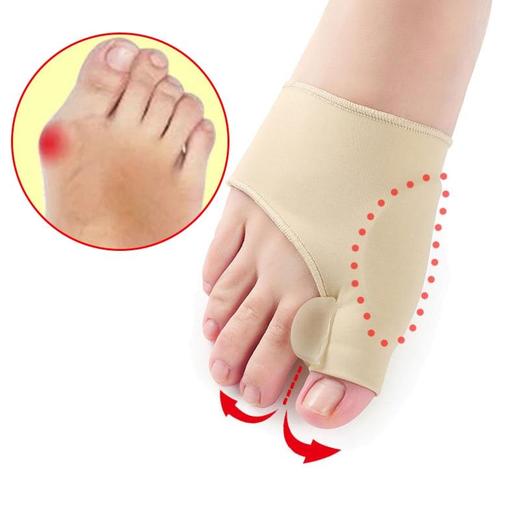Hallux valgus
What is ?
 The metatarsophalangeal joint of the big toe is the source of many painful pathologies of the forefoot due to its mobility and due to the constraints it supports when walking and when putting on shoes. It is formed by the spherical head of the 1st metatarsal and the concave base of the 1st phalanx. It is surrounded by a capsule and tendons whose concomitant damage contributes to joint pathology.
The metatarsophalangeal joint of the big toe is the source of many painful pathologies of the forefoot due to its mobility and due to the constraints it supports when walking and when putting on shoes. It is formed by the spherical head of the 1st metatarsal and the concave base of the 1st phalanx. It is surrounded by a capsule and tendons whose concomitant damage contributes to joint pathology.
What is a hallux valgus?
Hallux valgus is the most common deformity of the forefoot. It includes: a deviation outside the big toe, a deviation inside the 1st metatarsal and an exostosis (bump) on the medial surface responsible for painful bursitis by friction in the shoe (bunion in the popular jargon). This isolated deformity of the big toe if it evolves and increases can lead to deformations on the lateral toes.
There are a number of predisposing factors:
Hereditary family land.
Sex: more frequent pathology in women.
The presence of an Egyptian foot: excess length of the 1st phalanx.
Footwear: pointed shoes and high heels.
Why an operation?
Once the deformity of the big toe has been acquired, it no longer disappears and its evolution is inexorably towards progressive aggravation.
Unfortunately, there are no reliable non-surgical means to treat this deformity in a lasting way. Orthoses and insoles can be used at the beginning to delay the evolution.
The surgical decision is therefore based on several criteria, the personal evaluation of which by the patient is essential:
Pain tolerance.
Footwear tolerance.
Aesthetic tolerance.
In summary, it is when the patient has too much pain in their big toe, when they can no longer wear shoes as they wish or when they can no longer bear to see their deformation that surgical intervention is necessary. Knowing that the combination of these three criteria is not essential to the surgical decision; one may suffice.
Be that as it may, the results of the surgery are better if the deformity is moderate and if the treatment only concerns the big toe; It is therefore advisable not to delay too long and to avoid the decompensation of the deformation.
Definition
The most frequently performed intervention is the combination of a longitudinal osteotomy of the 1st metatarsal to correct its axis and erase the internal bump (bunion) and an osteotomy of the base of the 1st phalanx to realign the big toe.
Associated gestures are necessary depending on the deformation:
An exostosectomy: planing of the medial part of the metatarsal head.
A lengthening of the extensor tendon of the big toe.
Reaxating capsular plasty.
A correction of adjacent toe deformities.
Minimally invasive or percutaneous techniques are comparable in terms of bone procedures. Their realization is done by introducing strawberries through mini incisions. Their indication is interesting in moderate forms but requires rigorous postoperative follow-up, particularly if the maintenance of the correction is done by dressings. Their postoperative consequences concerning pain, work stoppage and swelling are comparable to those of conventional surgery because of the osteotomies, the consequences of which are identical.
The long-term result of these techniques is still being evaluated.
The procedure takes an average of 10 minutes.
Operative follow-up
 Hospitalization is short and varies between 2 and 3 days.
Hospitalization is short and varies between 2 and 3 days.
Dressings and especially a strict control of the algic phenomena is made during your hospitalization.
Walking can be done from the outset using a heel-supported shoe to be worn for 3 weeks.
Risks and complications
Complications following hallux valgus surgery are infrequent and exceptionally lead to revision surgery, however, they must be mentioned so that you can know them in order to understand them as best as possible if they occur.
Oedema It is constant and its presence is normal during the 6 postoperative weeks. Sometimes a swelling of the forefoot can persist longer and require draining massages.
Stiffness in the metatarsophalangeal joint is normal during the first few months, however this may occur extend in the case of capsulitis. The use of physiotherapy and possibly one or two cortisone injections may be necessary.
Algodystrophy This syndrome causing pain, stiffness and decalcification can be seen in any forefoot surgery . Injectable calcium treatment will be necessary. The evolution is always towards healing but this can take several months of evolution.
Disorders of sensitivity of the big toe This is a rare complication that is usually due to edema post operative. Recovery is gradual over several weeks.
The risks listed above do not constitute a completely exhaustive list. Your surgeon will give you all the necessary additional explanations and will be at your disposal to discuss each particular case with you.
The expected results of your operation
The advent of osteotomy techniques and the use of osteosynthesis equipment using buried intraosseous screws has considerably changed hallux valgus surgery, which has become simple and reliable. The same is true with anesthesia and pain control techniques that allow rapid indolence.
In the event of painful deformation of the forefoot, it is therefore no longer necessary to wait to have recourse to surgery. This treatment will bring you satisfaction both aesthetically and functionally by guaranteeing a rapid resumption of walking and activities.